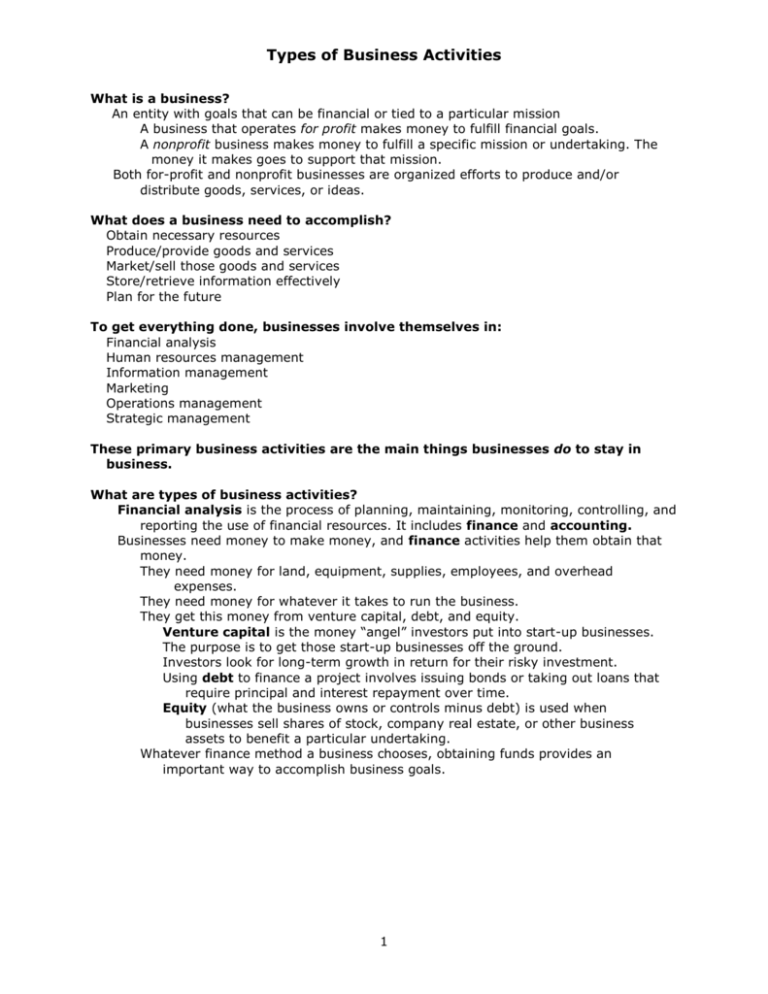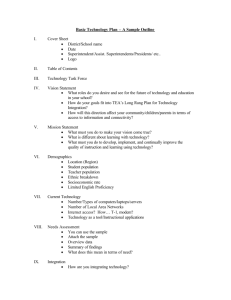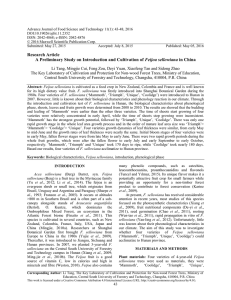Types of Business Activities - HSB-LHS
advertisement

Types of Business Activities What is a business? An entity with goals that can be financial or tied to a particular mission A business that operates for profit makes money to fulfill financial goals. A nonprofit business makes money to fulfill a specific mission or undertaking. The money it makes goes to support that mission. Both for-profit and nonprofit businesses are organized efforts to produce and/or distribute goods, services, or ideas. What does a business need to accomplish? Obtain necessary resources Produce/provide goods and services Market/sell those goods and services Store/retrieve information effectively Plan for the future To get everything done, businesses involve themselves in: Financial analysis Human resources management Information management Marketing Operations management Strategic management These primary business activities are the main things businesses do to stay in business. What are types of business activities? Financial analysis is the process of planning, maintaining, monitoring, controlling, and reporting the use of financial resources. It includes finance and accounting. Businesses need money to make money, and finance activities help them obtain that money. They need money for land, equipment, supplies, employees, and overhead expenses. They need money for whatever it takes to run the business. They get this money from venture capital, debt, and equity. Venture capital is the money “angel” investors put into start-up businesses. The purpose is to get those start-up businesses off the ground. Investors look for long-term growth in return for their risky investment. Using debt to finance a project involves issuing bonds or taking out loans that require principal and interest repayment over time. Equity (what the business owns or controls minus debt) is used when businesses sell shares of stock, company real estate, or other business assets to benefit a particular undertaking. Whatever finance method a business chooses, obtaining funds provides an important way to accomplish business goals. 1 Types of Business Activities Financial analysis is also about keeping accurate and useful financial records—and analyzing and interpreting the recorded information. These activities form the basis of accounting. By accounting for all expenses, and comparing expenses to income, businesses can make judgments and predictions about their own financial status. They can work toward: Being able to pay their bills Being able to make a healthy profit Human resources management is the process of planning, staffing, leading, and organizing employees. Every business needs people to accomplish the tasks intended to meet business objectives. Without employees, businesses would have difficulty operating. Although specific robotic machines can “replace” employees in certain manufacturing situations. Most businesses do not have machines that can perform job tasks as well as humans can. Most businesses must hire people to do the job. All employees of a business fall under the label of human resources. Besides “regular” employees, businesses usually require supervisors, managers, and executives. Human resources management covers everything the business needs in this regard. Human resources management involves: Planning for organizational changes Recruiting appropriate employees Selecting the “right” people to do the job Orienting new employees to their jobs Training employees in policies and procedures Evaluating employee performance Facilitating employee compensation Human resources management takes care of the responsibilities associated with having employees and makes the business a fair and inviting place to work Information management is the process of coordinating the resources pertaining to business knowledge, facts, or data. Each business should ensure that valuable information is available when and how it is needed. This will avoid the uncomfortable (and unprofitable) situation in which vital business information has been discarded or is unable to be retrieved. Businesses should have a system for: Identifying necessary information—includes knowing which facts the business will need to use in the future Determining how that information should be presented, viewed, or accessed Information can be viewed in formats such as reports, graphs, or spreadsheets. Format depends on how it is going to be used. Providing appropriate access to the information To access information, an employee could just walk to a file cabinet and pull out a client file. Or, the employee can do something complex, such as run an advanced query on a company database. 2 Types of Business Activities Situations in which having the right information at the right time can be critical to the success of a business include: When an airline needs to know who is flying on a particular airplane When a law enforcement officer needs to know if a specific person is a risk to the community When a board of directors needs to know the profits from last quarter When a sales representative needs to know if a product requested by a customer is available All of these things can be handled with technology, but how technology is used to manage information has changed—and will change—over time. Information management is not as much about pinning down the perfect technology for the task as it is about making sure that a reliable system is in place, so the business can make the best use of its information. Marketing is the process of creating, communicating, and delivering value to customers and managing customer relationships in ways that benefit the organization and its stakeholders. At first glance, marketing is simple: A good or service that is ready for sale is marketed to potential customers so they can buy it. But, long before a product is ready for sale, marketing is involved in the process of preparation. Marketing is present when the product idea is conceived. Marketing is present during the product’s design and creation. Marketing is actually involved in everything related to fulfilling a customer’s product needs. Marketing is put into action with activities such as: Locating potential customers by determining who will benefit from the product Pricing the product appropriately by finding out what customers are willing to pay Promoting the product to potential customers by communicating product benefits Getting the product into customers’ hands by completing sales transactions To accomplish these four things, an office-supply store would: Identify local offices and businesspeople who should know about the store and what it has to offer Conduct research, surveying the profit opportunity in its area Investigate what its competitors are doing—and how customers are responding to their prices Price its products slightly higher or lower, depending on its findings Make a point of advertising the benefits of popular products it sells Let potential customers know why products at this store are better than products at other stores Make the purchase process easy and seamless—by providing layaway, credit, or whatever customers might need to purchase the product immediately Operations is the process of planning, controlling, and monitoring the day-to-day activities required for continued business functioning. This includes such activities as: Production Quality concerns Safety and security Purchasing Inventory management Project planning 3 Types of Business Activities Expense control Property and equipment maintenance Every business needs to produce or provide its product, whether that product is a good or a service. One aspect of operations is production To produce a good, a business obtains supplies for manufacturing, “makes” the good, and then distributes the good to a warehouse or other holding facility. To provide a service, a business obtains the means for providing the service, and then provides the service to its customers. Operations also includes: Establishing the best processes for production and quality control Need to vary processes to reduce unnecessary procedures and wasted materials. Need to provide easy-to-follow instructions to increase the likelihood that employees will perform as needed Need to improve processes regularly to keep them up to date This leads businesses to engage in continuous process improvement by: Regularly evaluating how well the process works Finding its error points Correcting the errors as efficiently as possible Strategic management is the process of planning, controlling, and organizing an organization or department. Businesses need to know where they are in the “big picture.” Just having the money, hiring the workers, making/providing the product, and marketing/selling the product are not enough. They need to know: Are they headed in the right direction? Are they likely to experience long-term success? These questions can be answered by analyzing the strategic position of the company—and managing that position effectively. Need to establish the organization’s capabilities Need to determine how they can succeed in the long term and what will put them in reach of their goals Need to do what they’re capable of doing to reach the goals they’ve set for themselves Strategic management involves long-term planning and organizing for future success. Long-term planning involves creating the mission and vision of the business, determining its goals, and selecting strategies to support those goals. Long-term planning shows how the business intends to accomplish this. Organizing for future success includes determining what will be required to reach the long-term goals of the business. “Organizing” spells out how the business should be set up to meet its objectives. If the business plan changes, then strategies and tactics will also likely change. How are business activities interrelated or dependent on one another and work together? If a business (or a particular business project) changes in some way, the primary business activities must adjust in response. If one business activity has to change, the others have to change, too. Situation demonstrating interrelationship of primary business activities 4 Types of Business Activities Company ABC is a large business that makes and sells soft drinks to bottling companies. Since the company wants to gain the strategic position of the most unique beverage manufacturer in the industry, it has devised a plan for offering a new flavor of soft drink—feijoa. About the feijoa: A subtropical fruit, the feijoa grows primarily in South America, Australia, New Zealand, and California. Its aromatic flavor has been likened to that of the guava, but nothing can really describe the feijoa’s unique taste. The company feels that a feijoa-flavored soft drink will have an edge over “boring” lemon-lime soft drinks—and that the new product will bring in significant revenues. Before the revenues come flowing in, the company needs to obtain money to get the project started. As part of its financial analysis, Company ABC determines that the best way to bring in the necessary funds is through debt financing. The company feels certain that it can easily obtain a low-interest bank loan since it has an excellent credit rating. If the new product is a “winner,” the company will be able to repay the entire loan in a short period of time. All the company needs to do is make sure that the borrowed amount will cover the project’s expenses—including things such as: Salaries for employees in research and development Through its human resources professionals, the company hires the most qualified research-and-development experts it can find. It offers these employees competitive pay for their expertise, so that the company can rely on the end result of their work. Advertising for the new product From the marketing side of things, the company plans and develops suitable advertising. The advertising will let people know about the new product and when it will be introduced to the public. Tools and equipment necessary for production The company examines its operations—including tools and processes involved in producing the new soft drink. Although the company has purchased the best tools and has fine-tuned the production process over time, there remains one error that needs to be addressed. The company does not have an appropriate system for storing and retrieving the information involved in researching and developing this product, so it makes revision of its information-management system. A revision means the entire plan changes (if even slightly). Puts a strain on the financing available for the project, and causes every business activity to adjust In human resources management, the company must scale back the number of employees it hires to perform the product’s research and development. In marketing, the company must limit the number of advertisements it places to introduce the product. In strategic management, the company must align the change with its longterm goals. 5 Types of Business Activities In financial analysis, the company must determine if there is a way to avoid similar financing shortages in the future. Description of special situations When a business changes—internally or externally—it must adjust its primary business activities to suit its new situation. Example: If during strategic management a business decides that internal structure changes will help it be more effective in reaching its goals, human resources management and operations management will be affected instantly. New job descriptions, new tasks, and possibly new processes will be involved. New methods of managing information may be required. With financial analysis, the business will provide the financial means for making the change. Through marketing, the business will let the public know that the company is improving for the benefit of its customers. External business changes affect the primary business activities, too. Consider the effects of a merger between two large businesses. The goals of the two businesses change as the two companies become one. This means that the strategic management of the two businesses combines. The same thing happens with marketing, information management, human resources management, and financial analysis. What each business did before changes into what the single, united business does now. There are a few circumstances in which business activities are performed in an “out of the ordinary” manner—although with the technological progress, these situations are becoming much more common. Outsourcing Outsourcing involves using outside organizations or consultants to perform one or more of the primary business activities. When a business needs human resources management, it can hire an outside firm to perform the activity without hiring in-house employees for that purpose. Offering virtual services A virtual service is one that is offered through a medium of communication (such as the Internet), rather than in person. Example: online banking Instead of expecting customers to drive to your banking business, you can provide a way to complete their banking tasks through the Internet. The benefits of virtual services include speed and efficiency. 6







